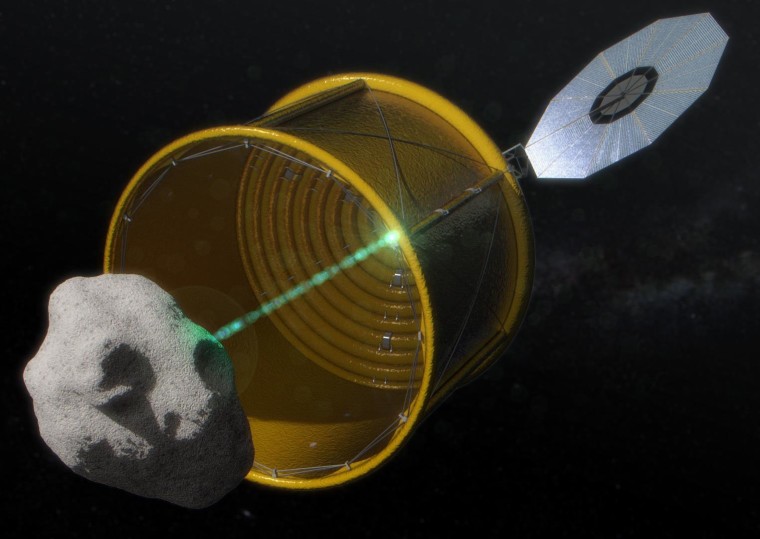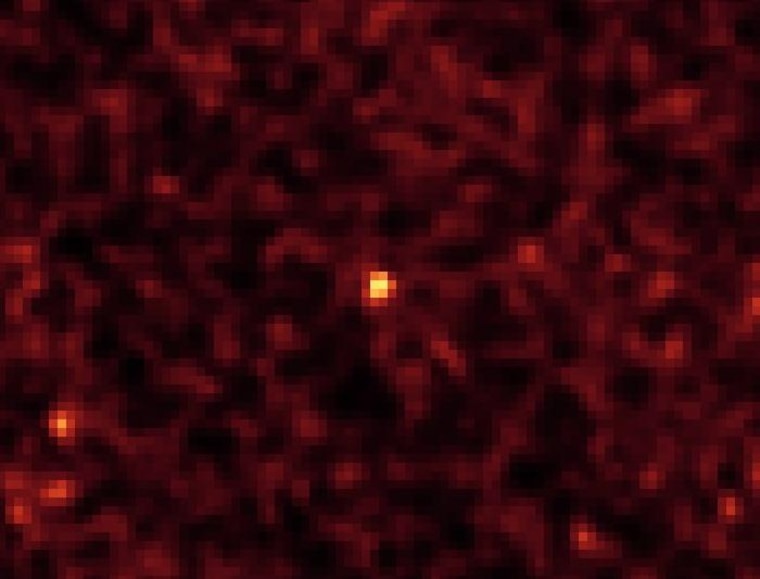Experts say it’s just a matter of time before a killer asteroid comes hurtling toward us – but NASA is making progress on plans to grab a space rock and test technologies that could someday save the world.
The space agency’s Asteroid Retrieval Mission aims to net an asteroid by the mid-2020s so that scientists can run experiments on it.
Sign up for Science news delivered to your inbox
Lindley Johnson, who's in charge of NASA's Near Earth Objects Program, explained the connection between netting a speeding extraterrestrial boulder and averting Armageddon on Thursday during a televised update on the space agency's Asteroid Initiative.
"Unfortunately, what you see in Hollywood is not always reality," he told NBC News. But he added that "the capabilities that we're looking at for demonstration by the robotic spacecraft are adding to our knowledge and techniques of what might be done for an asteroid that’s on a hazardous trajectory."
There are more than a million near-Earth asteroids out there, and experts estimate that about 20,000 of them have the potential to cause a city-sized catastrophe. Over the past 20 years, astronomers at NASA and other institutions have been making progress on cataloging the larger asteroids — but what if they find one that could pose a threat?
Practicing to protect the planet
That's where the Asteroid Retrieval Mission could make a start: The mission plan, which currently carries a price tag of $1.25 billion, calls for sending a solar-powered robotic spacecraft to snag a hunk of space rock — and bring it into a stable lunar orbit for study by astronauts.
Option A would involve grabbing one self-contained asteroid that measures less than 32 feet (10 meters) wide. Option B would be to pluck off a piece of a bigger asteroid and carry it back. Johnson said Option B would be better for practicing planetary protection.

For example, the spacecraft could serve as a "gravity tractor," passively using its gravitational force to shift the trajectory of the large asteroid ever so slightly over time. If the trick works, NASA could use it to "slowly tug" an asteroid out of Earth's path, Johnson said.
The probe also could use its solar electric ion propulsion system on the asteroid, as part of either Option A or B. Johnson said the ion thrusters would blast against the space rock, to see how much force is required to move how much mass over how long a time.
"We're supporting the ARM mission with our observation program, and in turn the ARM mission can support our planetary defense objectives," Johnson said.
More than survival at stake
The Asteroid Retrieval Mission isn't just about saving the planet: It's also aimed at adding to our knowledge about the solar system's basic building blocks, and providing a deep-space test bed for future missions to Mars and its moons.
Michele Gates, ARM's program director, said NASA will have to choose between Option A and Option B by the end of this year, with a mission concept review scheduled for February 2015. Launch of the robotic spacecraft is tentatively planned for 2019, with the asteroid rendezvous expected in the 2021-2024 time frame. The precise timing depends on which target is selected.
So far, NASA has identified three valid targets for Option A and three for Option B so far, Johnson said. One of the Option A targets, asteroid 2011 MD, was revealed on Thursday. It could be snagged during a close encounter with Earth in 2024, said Paul Chodas, an asteroid researcher at NASA's Jet Propulsion Laboratory.

NASA expects to keep adding to the list, potentially right up to the time of launch. "It won't be dozens, but it may be 10 or so by the time we get to make the decision," Johnson said. That's because any slip in the launch date could force NASA to switch from one target to another.
The Asteroid Retrieval Mission has come under sharp criticism from Congress and other quarters, on the grounds that the moon or Mars would be a more fitting target for exploration. In response, NASA has said the mission would serve as a warm-up for missions to Mars and its moons in the 2030s.
Even as the debate continues, the space agency is committing more money to asteroid exploration. On Thursday, NASA announced that 18 projects would receive a total of $4.9 million to work on asteroid mission studies. Some of the studies, such as Altius Space Machines' "Kraken Asteroid Boulder Retrieval System," would test prototype equipment for snagging a space rock. Other studies would focus on potential secondary payloads, such as the Planetary Society's LIFE on ARM experiment.
In addition to the Asteroid Retrieval Mission, NASA is supporting a variety of citizen-science initiatives through its Asteroid Grand Challenge program. The space agency's collaborators include Planetary Resources, Slooh and Space Gambit.
"There are great ways for the public to help with our work to identify potentially hazardous asteroids," Jason Kessler, program executive for the Asteroid Grand Challenge, said in a NASA news release. "By tapping into the innovative spirit of people around the world, new public-private partnerships can help make Earth a safer place, and perhaps even provide valuable information about the asteroid that astronauts will visit."